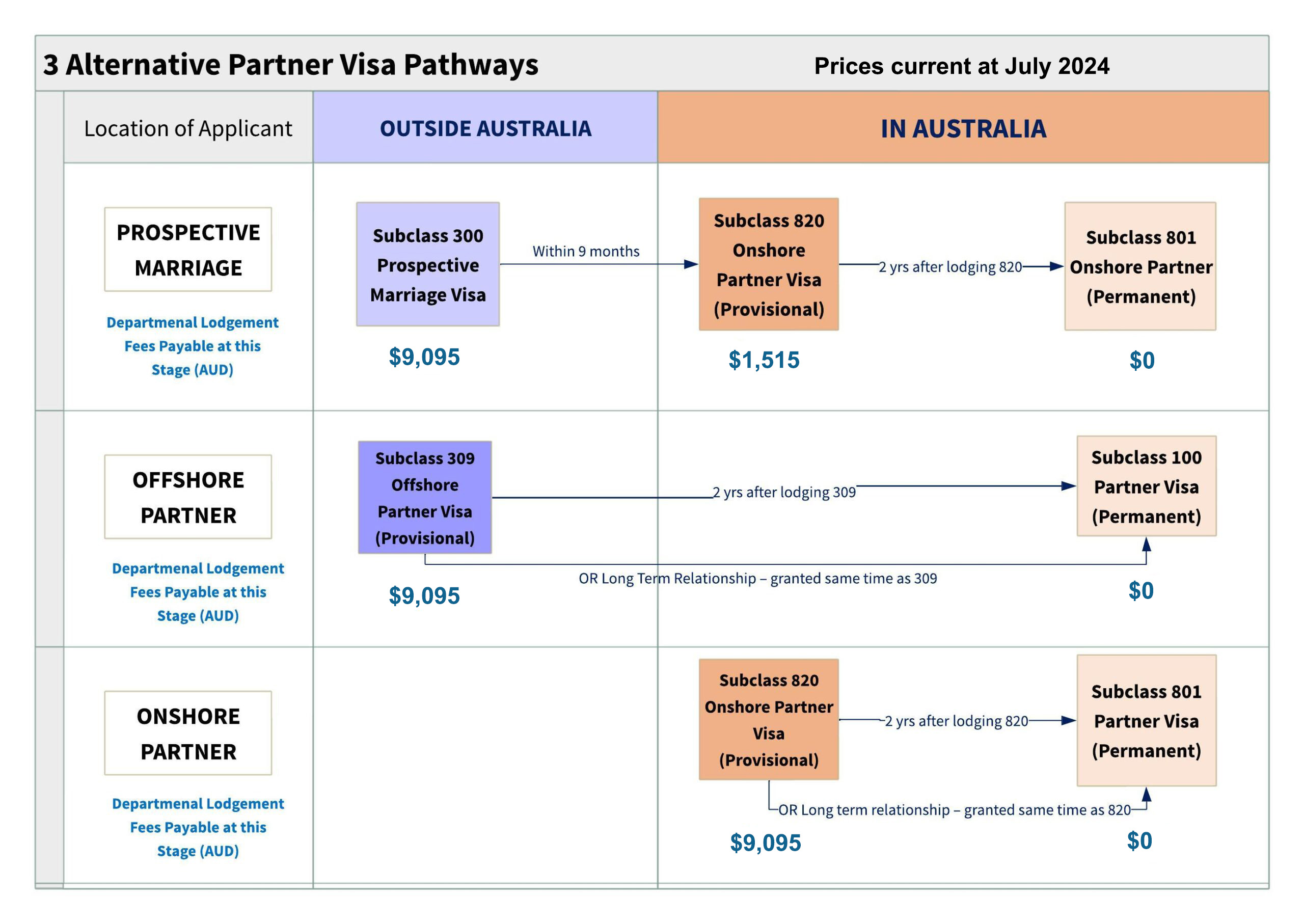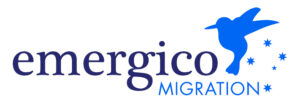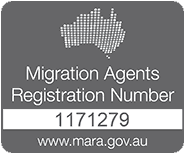Last updated: 18th October 2024
PARTNER VISAS
A fact sheet from Emergico Migration. You’re in a relationship with an Australian. Read about how you could obtain a visa on this basis.
You’re in a relationship with an Australian. Read about how you could obtain a visa on this basis.
An Introduction to Partner Visas
Partner Visas are available to people who are in a genuine, exclusive, ongoing and committed relationship with an Australian permanent resident or citizen, or an eligible New Zealand citizen.
They can be expensive and time consuming, and the processing time can be lengthy. Professional assistance from a Registered Migration Agent is strongly recommended.
On the positive side, the visa will give you the ability to live in Australia with your partner; unrestricted work, travel and study rights while in Australia, and a pathway to permanent residency.
Three Pathways to a Partner Visa
The right pathway for you will depend upon a number of factors including:
- The country your passport is registered to;
- The nature and duration of your relationship (e.g. married, engaged, de facto);
- Whether you have dependent children from another relationship;
- Your future plans as a couple;
- Whether you’re able to apply from within Australia, with a reasonable prospect of success.
This may suit someone who is outside Australia, and cannot demonstrate enough evidence for a Partner Visa, but genuinely intends to marry an Australian who they have met in person. The visa is granted on the basis the couple will marry within nine months of the visa being granted, after the applicant has visited Australia. They can then move forward with an application for a Partner Visa.
For partners outside Australia who can demonstrate that they are married or have been in a de facto relationship for at least 12 months, or have had their relationship registered as a Civil Partnership in Australia, with an Australian citizen or eligible permanent resident. The applicant must be outside Australia at the time of application, and may be in or outside Australia at time of decision. A Bridging Visa is generally not available to offshore lodged applications, but in specific circumstances it may be possible to obtain one.
For partners who are in Australia and can demonstrate that they are married or have been in a de facto relationship for at least 12 months, or have registered their relationship as a Civil Partnership in Australia, with an Australian citizen or permanent resident. The applicant must be in Australia on a temporary visa when the application is made, and decided upon. A Bridging Visa would be granted so if the applicant’s temporary visa expires before a decision is made on the partner visa, the applicant can remain in Australia with full work rights while waiting for partner visa decision.
(Subclass 300)
This may suit someone who is outside Australia, and cannot demonstrate enough evidence for a Partner Visa, but genuinely intends to marry an Australian who they have met in person. The visa is granted on the basis the couple will marry within nine months of the visa being granted, after the applicant has visited Australia. They can then move forward with an application for a Partner Visa.
(Subclass 309/100)
For partners outside Australia who can demonstrate that they are married or have been in a de facto relationship for at least 12 months, or have had their relationship registered as a Civil Partnership in Australia, with an Australian citizen or eligible permanent resident. The applicant must be outside Australia at the time of application, and may be in or outside Australia at time of decision. A Bridging Visa is generally not available to offshore lodged applications, but in specific circumstances it may be possible to obtain one.
(Subclass 820/801)
For partners who are in Australia and can demonstrate that they are married or have been in a de facto relationship for at least 12 months, or have registered their relationship as a Civil Partnership in Australia, with an Australian citizen or permanent resident. The applicant must be in Australia on a temporary visa when the application is made, and decided upon. A Bridging Visa would be granted so if the applicant’s temporary visa expires before a decision is made on the partner visa, the applicant can remain in Australia with full work rights while waiting for partner visa decision.
How the Partner Visa Pathways Work
Here’s a graphic that illustrates how each Partner Visa pathway works, including the current lodgement costs.

How is a Partner Visa Assessed?
When assessing your case, the Department will be looking for evidence that you are in a genuine, ongoing and exclusive relationship at the time you apply. They will predominantly assess four ‘pillars’ of your relationship, so it’s necessary to provide sufficient information and evidence about every pillar.
#1 The financial aspects of your relationship
– The degree to which you pool finances or support each other financially.
#2 The nature of the household
– Your living arrangements – do you live together or apart? Do you share a house with other people? How do you share household tasks?
#3 The social aspects of your relationship
– The degree to which you are known as a couple amongst your family and friends; and how you choose to spend your free time together.
#4 The nature of your commitment to each other
– How you provide each other with emotional support; and your future plans as a couple.
Sponsorship
To obtain a Partner Visa, you must be sponsored by your partner.
In order to be a sponsor, the Department of Home Affairs will ask a sponsor to provide police clearances from any country they have lived in for a year or more. Further, the results of any such police checks must be disclosed to the visa applicant.
The reason for this is to protect visa applicants from inadvertently becoming involved with partners who have a history of violent offences, including domestic violence and paedophilia, which may put the visa applicant or their dependent children at risk of harm.
A sponsor is expected to demonstrate they can take care of a visa applicant financially and meet their living costs, as it’s assumed that a partner applicant may take some time to become settled in Australia.
Right now, there is no set minimum income which must be demonstrated by a sponsor. If a sponsor has limited financial means, the Department may request a discretionary Assurance of Support from a third party, to protect the government from undue costs.
Under current law, a Partner Visa application is lodged first and then a sponsorship application is lodged. This process is expected to change in the near future, covered later on this page.
Costs associated with the process
A Partner Visa comes at a significant cost. Additional charges apply when you add children to the visa.
Given the lodgment charge is significant, many people prefer to trust a professional with their case, rather than risk getting something wrong and forfeiting the lodgment charge, which would not be refunded in the event of refusal.
We specialise in Partner Visas and can help at all stages of the process, from checking initial eligibility, to preparing sufficient evidence, building the best possible application, lodgement and management of the case, through to finalisation and visa grant by the Department.
We will give your case our best attention, combined with an up to date knowledge of law and policy, and trends in processing.
As noted, a Partner Visa application can involve two or three stages. We charge a fixed price fee for assistance with each stage, and can provide a personal quotation following an initial eligibility consultation.
Frequently Asked Questions
Visas are granted in accordance with Australian laws and values.
For this reason, there are certain relationship types which would not be considered eligible for a Partner Visa. These include:
- Prohibited relationships – e.g. when the two partners are related by birth;
- Polygamous relationships;
- Forced marriages;
- Relationships where one of the partners is under the age of consent (18 in Australia – however a partner visa may be granted from age 16 as long as there is parental consent to the marriage);
- Non-genuine relationships, or relationships which have been constructed for the purpose of obtaining a visa.
If a Partner Visa applicant has a child from a previous relationship, the child may be added to the application provided they are still dependent on the applicant and aged under 23.
If the child is under 18, the non-custodial parent, or anyone else who has a legal right to determine where the child lives, must provide written consent for the child to be granted a visa.
Alternatively, if the applicant holds a court order giving them the sole right to determine where the child lives, no such consent is required.
Occasionally, a person applies for a Partner Visa but does not add their children at the same time. If the provisional visa is already granted, and the applicant now wishes to add a child to the application, they must apply for a separate Dependent Child visa. Once granted, the child can then be added to the permanent Partner application, under sponsorship of the sponsor.
A Bridging Visa is a special type of interim visa that keeps you lawful while waiting in Australia for a visa to be granted while you are onshore. For this reason, you can only usually obtain a bridging visa if you apply for the onshore Partner Visa (820).
A Bridging Visa A which is granted after lodging an 820 visa, has unrestricted work and study rights, when it is ‘in effect’. The Bridging Visa will come into effect after any visa that you currently hold expires. In certain circumstances it may be possible to obtain a Bridging Visa A, after lodging an offshore partner visa (309/100), and subsequently entering Australia.
The usual bridging visa granted after lodging is a Bridging Visa A (BVA). This has no travel rights, however if you wish to travel you can obtain a Bridging Visa B (BVB). There is a small cost associated with a BVB.
In some cases you might have a different Bridging Visa, e.g. a Bridging Visa C, D or E, if you were not lawfully resident when you lodged your application for a Partner Visa. Bridging visas other than BVA are not eligible for a BVB, so you would be unable to re-enter Australia if you left Australia while holding one of these visas.
Bridging Visas are complex, and we’d encourage you to book a consultation with us to discuss your situation if you feel this may be relevant to you.
In the event of a relationship breakdown, it is necessary to inform the Department about a change in circumstances.
- If the application has been lodged but not decided; or if the Prospective Marriage or Temporary partner visa has been granted, the applicant will receive a Natural Justice Letter, affording them the opportunity to comment on the information they have received.
- After 28 days, unless there are reasons and evidence provided which would support granting the Partner Visa in spite of not having a sponsor, the application would be refused, unless withdrawn prior.
- There are specific circumstances in which a Partner Visa may still be granted in spite of there being no sponsor. This requires individual advice.
- If the permanent Partner Visa has been granted when a breakup occurs, there is no impact on the visa.
- Normally, when assisting with a Partner Visa, we assist both the sponsor and the applicant with their parts of the process. In the event of a breakdown, we would have a conflict of interest and would no longer be able to represent both parties as their Migration Agent.
Why would I choose Emergico as my Migration Agent?
We have a team of qualified Registered Migration Agents who are highly experienced and knowledgeable about Partner Visas, and have a solid history of excellent results for our clients.
All our Agents are members of the Migration Institute of Australia and keep up to date with law changes and events which might impact on our clients. We communicate regularly with clients so that they are always fully informed about matters that will affect them, and we advise accordingly.
Our CEO, Leanne Stevens, who heads up our team, has served as the National Vice President of the Migration Institute of Australia. Our team access to the very latest policy developments and trends, giving our clients the edge, under our maximum possible care.


Emergico Migration is an Australian based Registered Migration Agency which provides advice and visa assistance for people wishing to move to, or remain in, Australia. We specialise in Employer Sponsored, Skilled, Global Talent, Parent, Partner, Family, Student and Graduate Visas.
You can contact us by emailing: migrate@emergico.com, calling us on (7) 3861 0726, or visiting our website at www.emergico.com




